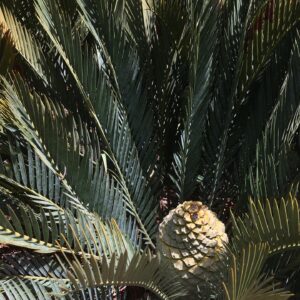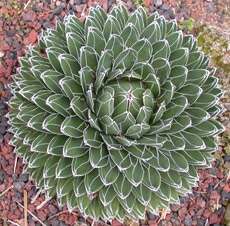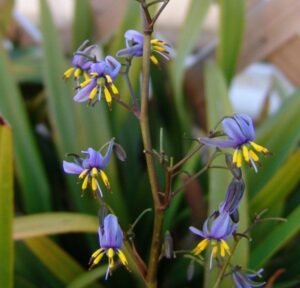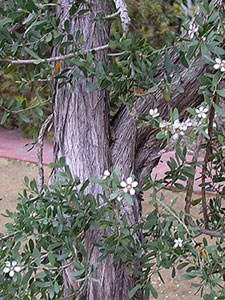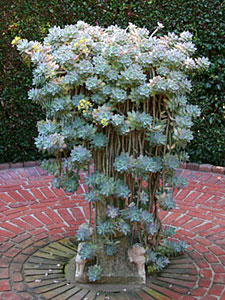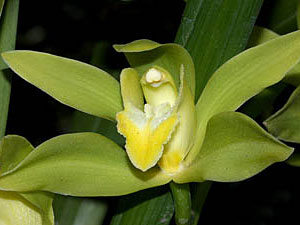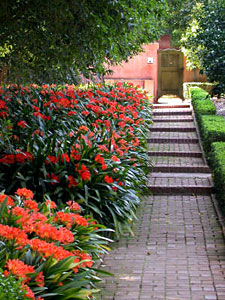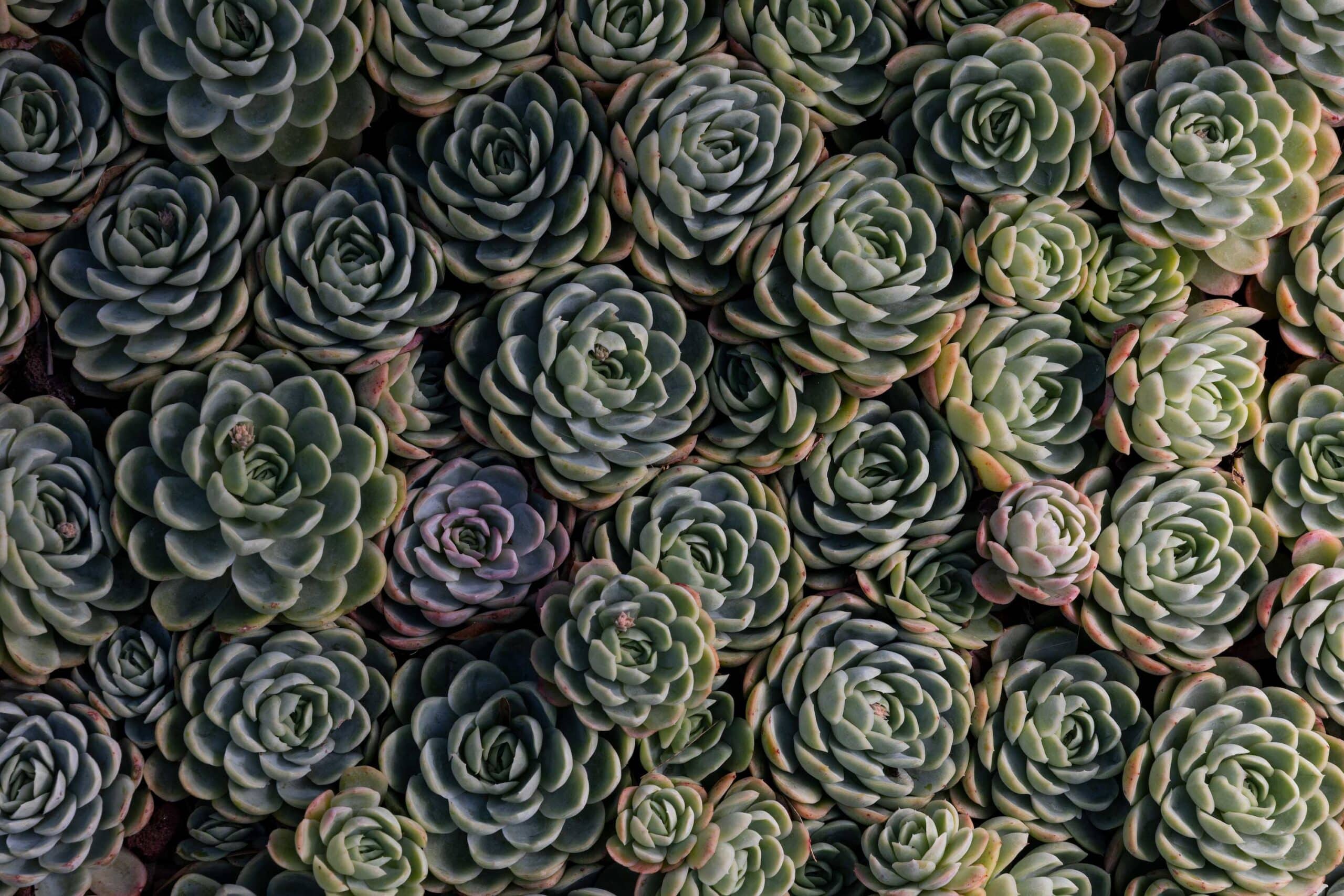
Plant Highlights
April
-
Aechmea recurvata v. benrathii
Highlight Month:
April
Nativity:
Santa Catarina, Brazil
Growth Habit:
This low-growing clumping bromeliad makes a great addition to a small area or rock garden. In habitat it grows on rocks near beaches.
Growing Requirements:
Most Aechmea grow easily in Santa Barbara and A. recurvata v. benrathii is no exception. It is not picky about soils and will grow epiphytically or in the ground. Water overhead once a week during dry periods. Hardy to 25°F.
Leaf size and color is highly variable, depending on light levels. When grown in full sun, plants are very compact (4” high) with black-spotted bulbous leaf bases and purple tips. When grown in shade, the leaves become lanky and dark green, but the plant will still flower.
Features:
When individual plants in the clump are ready to flower the inner leaf sheaths flush bright pink and hold a sunken inflorescence of pink flowers maturing to lavender. Flowering plants in the cluster eventually die but produce abundant offsets.
It was named and described by Carl Mez in 1919 as Aechmea benrathii in honor of Karl Benrath, a church historian from Königsberg, Germany, and later given varietal status in 1952. Aechmea comes from the Greek, aichme, meaning spear point, in reference to the pointy bracts and sepals of some species. The specific epithet, recurvata, refers to the backwards curving leaves.
Where at Lotusland:
Upper and Lower Bromeliad Gardens

-
Doryanthes palmeri
giant spear lily
Highlight Month:
April
Nativity:
Australia: McPherson Ranges of southeast Queensland and northeast New South Wales. In habitat, it grows in evergreen forests on exposed rocky volcanic outcrops that experience frequent fires.
Growth Habit:
This species grows to large proportions with vertically furrowed 6-8’ tall leaves and makes for a dramatic feature in the garden. In the spring, plants produce large showy bent flower stalks, resembling large toothbrush heads, and display bright red cup-like flowers lined with white. Flowers later develop into a brown egg-shaped capsule filled with papery seeds. After flowering, the spent rosette dies but is replaced by numerous leaf rosettes emerging in the clump.
Growing Requirements:
D. palmeri thrives in full sun and will also grow in part shade where it may flower infrequently. It is drought tolerant once established and can handle nutrient-poor soils. Giant spear lilies do not require low-phosphorus fertilizers like many other Australian native plants. This species generally takes about ten years to flower when started from seed and is popular with birds seeking its abundant nectar.
Features:
The genus Doryanthes is endemic to eastern Australia and contains only two species in the family Doryanthaceae. The other species, D. excelsa, is similar in overall appearance but forms an erect inflorescence with a cluster of terminal red flowers. D. palmeri flower stalks and roots are a food source for Aboriginal Australians and the leaves are used to make ropes and woven products. The genus name comes from the Greek, doratos (spear) and anthos (flower), referencing the flowers found on the spear-like stalk. The specific epithet honors Sir Arthur Hunter Palmer (1819-1898), an Irish-Australian sheep farmer and politician.
Where at Lotusland:
Australian Garden and Main Lawn near entrance to the Lower Bromeliad Garden
-
Furcraea macdougallii
MacDougall’s century plant
Highlight Month:
April
Nativity:
This Mexican Agave relative is native to Oaxaca, Chiapas, and Puebla where it grows in dry forests at elevations of 2,600 to 3,300 feet.
Growth Habit:
Mature F. macdougallii form a swollen trunk up to 15 feet tall topped with a rosette of thick dark green leaves reaching 7’ in length with curved marginal teeth. This species is monocarpic and will die after flowering. However, the dramatic 20’ inflorescence produces hundreds of bulbils (small plantlets) that can be easily propagated as clones of the parent plant.
Growing Requirements:
This species prefers full sun and has very low water needs.
Features:
F. macdougallii was first described by Eizi Matuda, a Japanese-born Mexican botanist who named this plant in honor of his friend Thomas MacDougall, a Scottish naturalist who studied southern Mexican flora for almost 50 years. MacDougall is credited with discovering this plant in the wild near Tehuantepec in Oaxaca.
Where at Lotusland:
At Lotusland there are three specimens of F. macdougallii near the intersection of the Succulent Garden and Blue Garden. These plants were donated to Lotusland from the International Succulent Introductions (ISI) 1965 distribution via the UC Santa Barbara Greenhouses and planted in 1995.
-
Encephalartos lehmannii
Karoo cycad
Highlight Month:
April
Nativity:
This cycad hails from the Eastern Cape of South Africa where it grows on semi-arid sandstone slopes.
Growth Habit:
Mature plants can reach 4-6’ tall and form a clump with pleasing blue leaves with recurved tips.
Growing Requirements:
E. lehmannii can withstand dry conditions once established in the landscape, prefers full sun, and is frost tolerant (25-30°F).
Features:
The name honors Professor Johann Georg Christian Lehmann, a 19th century German botanist, who published several papers on cycads and described the genus Encephalartos.
Where at Lotusland:
Cycad Garden
-
Agave victoriae-reginae
Queen Victoria agave
Highlight Month:
April
Nativity:
NE Mexico (Coahuila, Durango, Nuevo León)
Growth Habit:
This geometrically pleasing agave grows in a tight rosette with distinctive white markings on its leaves. It is native to the Chihuahuan Desert in Mexico where it grows in limestone between 4,000-5,000’ in elevation. After reaching a considerable age, this species will produce yellow to reddish-purple flowers on an impressive 15’ spike. It rarely offsets and dies after flowering so new plants must be propagated via seed or tissue culture.
Growing Requirements:
Full sun, well drained soil with little water.
Features:
Due to its small size and slow growth, this agave makes an excellent container plant, though keep it away from walkways since each leaf is tipped with one very sharp spine. The specific epithet honors Queen Victoria, ruler of Great Britain and Ireland from 1837-1901.
Where at Lotusland:
A planting of A. victoriae-reginae grows on the slope along the path to the Water Garden.
-
Dianella tasmanica
Australian iris, flax lily
Highlight Month:
April
Nativity:
D. tasmanica is native to SE Australia including Tasmania.
Growth Habit:
A clumping perennial with strap-shaped leaves growing 3-4 feet tall and 2-3 feet wide. It spreads rapidly by underground rhizomes.
Growing Requirements:
It will grow in sun to partial shade; it needs more shade in hot climates. It can be drought-tolerant but the foliage will look better with some additional water. Grows best in well-drained soil.
Features:
Clusters of small blue star-shaped flowers in spring are followed by bright blue berries which hang on their stems for over a month. There is a cultivar ‘Variegata’ that has white-striped leaves.
Where at Lotusland:
Flax lily is planted in many of the beds bordering the Visitor’s Center parking lot in the Australian Garden.
-
Leptospermum laevigatum
Australian or coastal tea tree
Highlight Month:
April
Nativity:
Coastal dunes of southeastern Australia
Growth Habit:
Leptospermum laevigatum can be easily trained into different forms. If the lower growth is pruned away, it will develop into a small tree 30 feet tall by 20 feet wide. Young plants can be placed close together to make a hedge or windbreak. They can also be trained over a fence or arbor. There are a few cultivars including ‘Reevesii’, a compact form growing to only 5 ft. x 5 ft., and ‘Raelene’ which has variegated foliage.
Growing Requirements:
Australian tea tree does best in full sun to partial shade, and needs good drainage in a slightly acid soil or neutral soil. If planted in heavy clay soils it may become chlorotic or develop root rot. Once established it is a drought tolerant and salt tolerant plant. Cold hardiness is around 20 degrees.
Features:
The finely textured olive-green foliage is arranged on weeping branches. Small white flowers bloom in spring. The trunk has unusual shaggy, fibrous bark and older specimens develop twisting, gnarled branches which spread out along the ground. The commonly used tea tree oil is not derived from this species, but instead from Melaleuca alternifolia.
Where at Lotusland:
The Tea Tree Arbor at the Visitor’s Center. There are also some specimens in the surrounding Australian Garden.
-
xGraptosedum
Highlight Month:
April
Nativity:
Garden Origin
Growth Habit:
This succulent plant is a hybrid between Graptopetalum paraguayense and Sedum adolphi. It combines the gray-green rosettes of a Graptopetalum with the yellow flowers of Sedum.
Growing Requirements:
Full sun or partial shade and well-drained soil are needed. Plants are frost tender, but can be grown in pots and wintered indoors if kept dry.
Where at Lotusland:
This specimen is planted in an antique baptismal font on the Parterre.
-
Cymbidium lowianum var. concolor
Highlight Month:
April
Nativity:
Assam to China (S. Yunnan) and N. Indo-China
Growth Habit:
This orchid in the genus Cymbidium has long arching sprays of medium-sized flowers. The plant eventually forms large clumps and blooms for several months in spring.
Growing Requirements:
Partial shade and typical orchid bark as a substrate. Fertilize on a regular schedule with water soluble products developed just for orchids.
Features:
This variety lacks the distinctive red lip of the straight species and comes from the periphery of its native distribution.
Where at Lotusland:
This specimen is planted in the large cast iron whaling pot. This pot was used to boil down whale blubber for its valuable oil.
-
Clivia hybrids
Highlight Month:
April
Nativity:
Cultivated origin, but the several species from which they were hybridized are native to South Africa where they are known as the “flame of the forest.”
Growth Habit:
Clivia are perennials growing in clumps of dark green, glossy leaves are handsome year round. In spring, each clump produces a single flower stalk topped with a profusion of tubular flowers. The species are typically orange, but many forms from pink, salmon and now the rarest, yellow are available. There are even variegated selections.
Growing Requirements:
Full to partial shade and moderate water are needed. They can tolerate some dry periods in winter. Plants are frost tender.
Where at Lotusland:
There is a mass planting across from the Citrus Orchard and several clumps in the Fern and Tropical Gardens. The yellow flowered form is across the path from the drinking fountain in the Fern Garden.




